What does bignoniform catalpa look like and how to grow it?

Catalpa is a tree that naturally grows mainly in the southeast of North America. However, the plant often becomes a guest of Russian gardens. The thing is that it is an aesthetic and picky culture. Consider one of the plant species - bignoniform or ordinary catalpa.
general description
A subtropical culture is a tree or shrub. The plant is decorative, and therefore is grown for landscaping parks and squares. In nature, trees reach a height of 10 m, their root system goes very deep into the ground, and therefore the plant prefers to grow in rich moist soils. The trunk is massive, branched, the crown is powerful, strong, with simple green (yellow in spring) smooth heart-shaped leaves, which are 30 cm long and 15-18 cm wide.
The flowers of the catalpa are bisexual, they look like bells, their size is 2-3 cm, the petals are white, pink or cream, and red spots are observed on the inside. In one inflorescence, 10-25 flowers are formed. The fruits are long, hanging, are green pods with seeds, when cold weather sets in, they change color to brown, but remain on the tree during the winter.
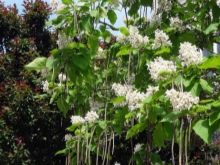


Flowering starts in the second half of June. At this time, the tree is not only decorated with flowers of amazing beauty, but also exudes a very pleasant, refined aroma that attracts bees and butterflies, so the garden where this culture grows is always filled with a summer fabulous mood. By the way, flowering trees are excellent honey plants.
Another property of catalpa is the medicinal qualities of its bark and leaves, which have a very rich chemical composition. Let's consider it in more detail:
-
phytoncides have an anti-inflammatory and bactericidal effect;
-
glycosides contribute to the elimination of parasites from the body, and also relieve toxins and toxins, alleviate the phenomenon of diarrhea;
-
bioactive substances have an anticarcinogenic effect, inhibit the growth of cancer cells;
-
substances found in leaves and pods can be used to relieve symptoms of bronchitis and bronchial asthma;
-
infusion of the pods can lower blood sugar.
The plant extract is also used in cosmetology, it is added to creams, gels, emulsions, after which the funds are applied to damaged, tired skin. And oil is also prepared from the seeds, which dries quickly in the sun and hardens - this material is used in the manufacture of some building paints and varnishes.


Popular varieties
The following varieties are considered the most common.
-
Aurea. A feature of the plant is the foliage of a golden hue. In the central zone, the tree is cultivated as a compact shrub up to 2 m in size. In winter, the branches freeze, but in spring they recover well after sanitary pruning.

- Nana. This shrub has an aesthetic ball-shaped crown, and its advantage in terms of agricultural technology is its high frost resistance. Therefore, the variety is allowed to be planted in the middle lane, but there are no flowers on such a tree.

- Kene. This species has very beautiful large bright green leaves with a yellow frame.
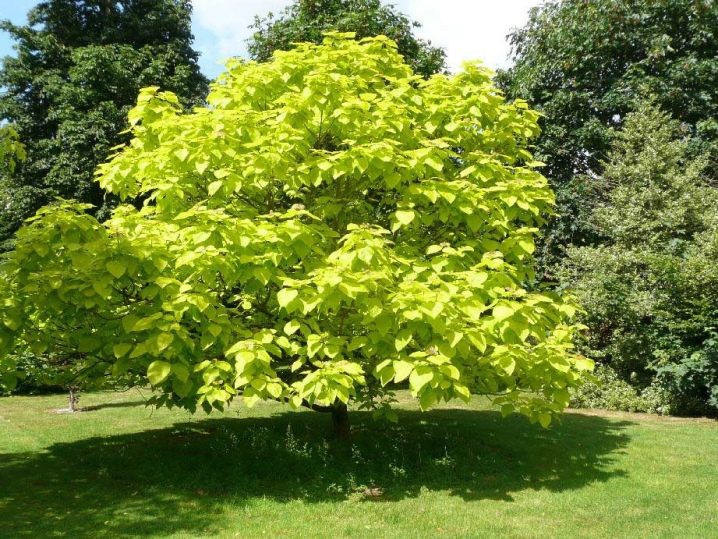
- Purpurea. It is a low-growing tree up to 3-5 m in height, which has a wide round crown with beautiful purple leaves. The flowers are large, white, with purple spots.
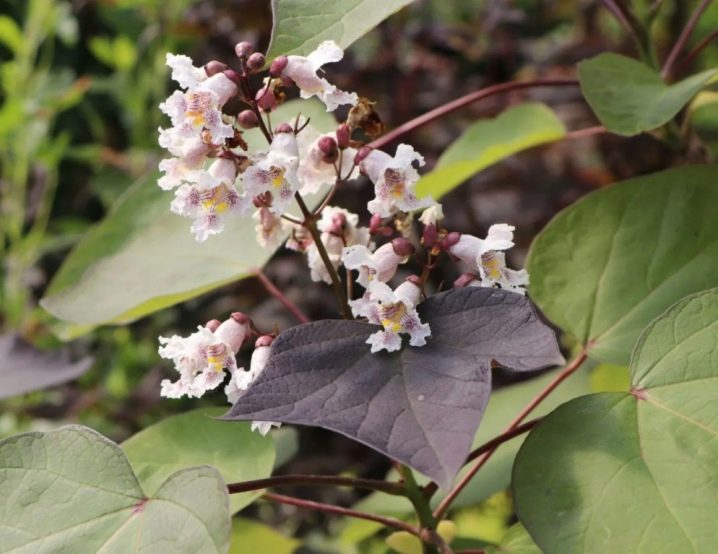
Landing
For planting, choose areas that are well lit by the sun, or partial shade. Usually the tree is planted along garden alleys, on the banks of water bodies, in the center of the lawn. Choose annual seedlings sold in specialty stores as planting material, as these specimens are already adapted to the conditions in which they will be grown.
This culture is unpretentious to the soil, but it will feel more comfortable in moist, slightly acidic drained soil with a high organic content. The optimal time for disembarkation is early spring. The planting process consists of the following stages.
-
Dig a hole one meter deep. Maintain a distance of at least three meters between future bushes.
-
Combine river sand, garden soil, peat and humus in a ratio of 2: 2: 1: 3. Add wood ash and phosphate rock to this.
-
At the bottom of each pit, lay a drainage layer of broken brick or shards. Place the previously obtained composition on the next layer.
-
Plant the shoots vertically in the center of the holes. Do this very carefully. Dig in the ground around the seedlings.
-
Moisten the planting site liberally, and apply a layer of mulch, such as peat is suitable.
Keep in mind that planting should be done in such a way that the root collar is at the level of the ridge. Also consider subsidence and soil compaction.


Care
If the plant is planted in a rich drained land, then it will develop well, reach for the sun, the green crown will grow every season. In short, growing a crop looks like this:
-
the tree needs to be watered periodically;
-
carry out sanitary pruning of shoots;
-
feed with organic and mineral compounds;
-
during cold weather to protect the tree under cover.
Let us dwell on several points in more detail.
Watering
The tree needs watering every week. Each instance needs at least two buckets of water at a time. If the summer is cool, then three irrigations per month will be enough for the plant. At least twice a season, gardeners are advised to plow the ground in the near-trunk circle after watering, as well as remove weeds that prevent the free penetration of moisture, oxygen and nutrients to the root system.
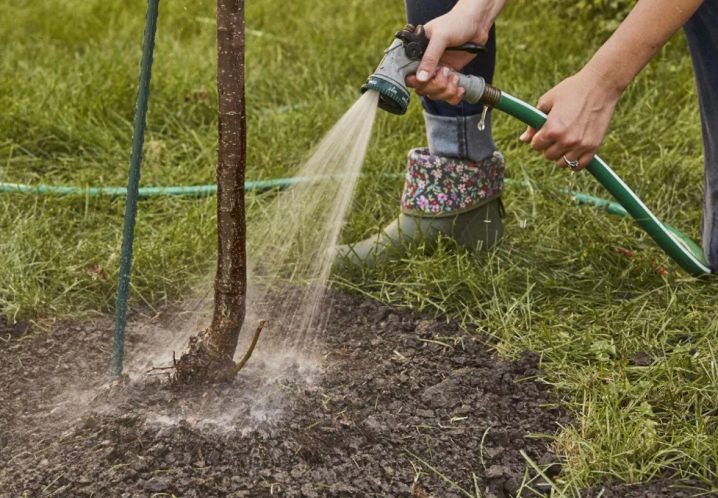
Wintering
For young bushes, it is imperative to prepare a winter shelter. Most often, gardeners use spruce branches, burlap or other covering material. Such protection will protect the roots from frost. Mature trees do not need insulation; it is enough to add a layer of mulch around the trunk in the form of dry foliage. If during the winter the tree is slightly frozen, then in the next season it can grow back.
Pruning
The tree of the presented culture needs mandatory sanitary pruning, which is carried out in the spring. The procedure consists in removing dry, weak, frozen branches during the winter. After the elimination of diseased shoots, new young healthy branches will begin to grow in their place. To give the crown aesthetics, many gardeners also carry out decorative pruning.
Fertilizers
This plant responds very well to feeding with organics or minerals. Twice a season, you can add slurry, but before that, irrigation must be carried out so that nutrients can penetrate well to the root system and other parts of the culture.
One of the dressings can be changed to a universal composition.

Reproduction
There are two ways to breed bignoniform catalpa.
Seeds
Before sowing, the planting material must be soaked in warm water and kept there for 12 hours. The optimal time for sowing is February or March. After planting in the substrate, the container must be placed in a place with diffused sunlight and covered with a film.
The first shoots can be observed in about a month, but this is provided that the temperature is at + 15 ... 20 degrees, and the landing site will be regularly moistened. When the sprouts hatch, the shelter can be removed.Until May, the care of the seedlings continues, and in May they are transplanted to the garden plot.
At first, the summer resident should be especially sensitive to the care of the crop, so that the young seedlings adapt well to the new place and continue to actively develop.
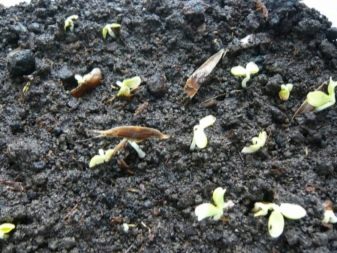

Cuttings
Breeding by cuttings is carried out in July or August. Cuttings 10 cm long are suitable for planting. They are placed in a substrate consisting of peat and sand, but it is advisable to pre-hold the planting material in a growth stimulator for easier adaptation to new conditions. Planted cuttings need the same care as bushes grown from seeds. Seedlings can be transplanted to the site when sprouts and roots hatch on them.

Diseases and pests
This plant has a strong immunity against insect damage and diseases, but if the growing conditions are not followed, this problem does not bypass it.
Basic rules for protecting crops from diseases and pests.
-
If the bush was attacked by a Spanish fly, then such means as "Kinmiks" or "Decis" will be able to overcome it.
-
If the gardener noticed that the buds of the tree have suffered from pests, then the plant must be treated with insecticides. It is important to be in time before bud break, otherwise the branches will develop in a curved shape.
-
When watering, it is required to avoid waterlogging of the soil, as this threatens the spread of the fungus. Already at the planting stage, it is important to organize a drainage system in the planting pit. And also to prevent fungal ailments, it is recommended to use loose soil for planting, which is good for moisture permeability.
-
Often the tree becomes a victim of anthracnose. You can recognize the disease by the spots on the leaf plate. To protect against this ailment, use universal fungicides, which, in addition to anthracnose, will protect the bush from powdery mildew, aphids and other parasites.
-
As a preventive measure against diseases and pest attacks, once a month treat trees with special protective substances, which are bred according to the instructions.
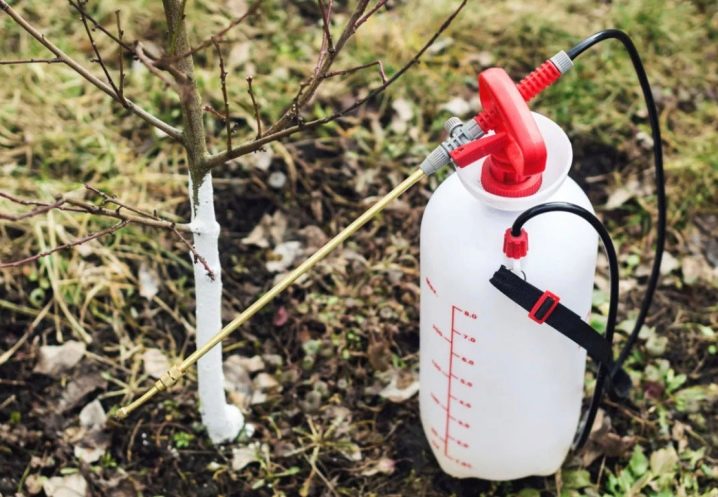





























































The comment was sent successfully.